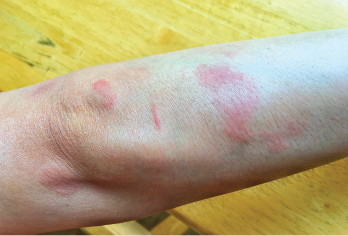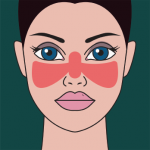
Skin manifestations of SLE.
korn ratchaneekorn / shutterstock.com
CHICAGO—David A. Isenberg, MD, academic director of rheumatology, University College London, presented the ACR Systemic Lupus Erythematosus (SLE) State-of-the-Art Symposium at the 2018 ACR/ARHP Annual Meeting.
Dr. Isenberg began by noting lupus is now widely covered in the news, but singer Selena Gomez has probably done the most to increase awareness of the disease; her 2017 kidney transplant Instagram received more than 10 million likes. He encouraged rheumatologists to match this awareness and “up our game” with clinical assessment and understanding the totality of the effects of lupus on the patient.
Early recognition and treatment of SLE is important, Dr. Isenberg emphasized. Physicians should also be aware that damage from lupus implies permanent change, and lupus presents differently in different age groups. Although blood tests results reveal immunological changes in all patients, younger patients tend to have lower levels of C3. Younger patients are also more likely to have alopecia.
Treatment Strategies
Dr. Isenberg described SLE treatment strategies, explaining patients who have mild disease with fatigue and only malar rash should be treated with a single shot of steroids, with the possible addition of hydroxychloroquine (HCQ) and topical steroids. These patients can continue on a moderate dose of steroids and HCQ. Recent research suggests the use of glucocorticoids is more tightly associated with the treatment center than with patient symptoms or patient outcomes, meaning it may be possible to maintain patients without glucocorticoids.
However, patients with moderate disease will likely require steroids and a maintenance dose of prednisone, Dr. Isenberg noted. These patients tend to present with fever and a larger rash. Although they may have renal involvement, it is not severe. In contrast, patients with severe disease tend to have large rashes, as well as severe pleurisy and/or pericarditis. These patients require more medications and are more likely to require steroids and immunosuppressive drugs for an extended period. Antimalarial agents, such as HCQ, adjunctive therapies and immunomodulation should all be considered as treatment options. Patients with lupus nephritis should be treated with immunosuppression for at least three years.
“Clearly, one has to see lupus patients regularly,” emphasized Dr. Isenberg, because it is vital to monitor drugs used in therapy closely. Regular visits should include serological tests, because an increase in double stranded DNA antibody is associated with an increased risk of renal disease. Regular management should also include awareness of the increased risk for infection, cancer, vascular disease and osteoporosis; previously the major concern for patients with SLE was kidney failure.
Moreover, Dr. Isenberg pointed out the importance for healthcare providers to recognize concomitant damage may not necessarily be the result of disease activity. Shortness of breath, for example, could be due to pleuritis or pulmonary fibrosis. For each symptom, it is critical to question whether the symptom reflects disease activity or damage.

